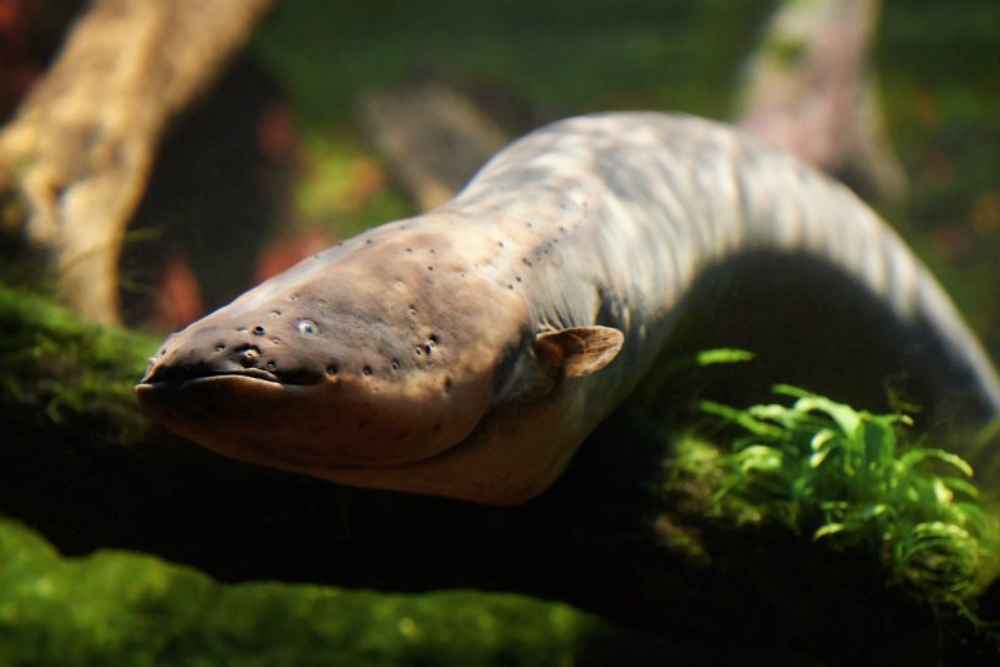Did you know that some fish can make electricity? It is an amazing ability that only certain species of fish possess.
As intriguing as this may sound, it is a necessary trait for these species in order to survive and thrive underwater.
If you want to learn more about the process of how do eel produce electricity, then read on to discover the electrical capabilities of some remarkable creatures.

Electric Eel
The electric eel is a powerful freshwater fish from South America that can produce a strong electric shock, up to 300 to 800 volts, enough to unconscious a human being.
The electric eel is a species of eel that is native to South America and primarily found in the Amazon and Orinoco basins.
They live in freshwater environments such as rivers, swamps and flooded forests.
Electric eels have a long, cylindrical body that can grow up to 8 feet in length and weigh over 44 pounds.
They have a unique body structure that allows them to generate strong electric discharges for navigation, defense, and hunting.
Electric eels have a specialized organ called an electrocyte that runs the length of their body and allows them to produce electric charges of up to 600 volts.
Additionally, they have a large mouth with many sharp teeth that they use to capture prey.
How Do Fish Produce Electricity?
Fish do not generate electricity. Some species of fish, such as electric eels, can produce electric shocks for navigation, defense, and hunting.
These electric fields are generated by special cells called electrolytes in the fish’s body, which store and release electrical energy.
The electric eel, found in South America and Lake Tanganyika, is not an eel but a knifefish species.
It can generate an electric shock of 860 volts and 1 ampere of current, which while strong, is not usually deadly to humans.
Fish Species Produce Electricity
There are various species of fish that produce electricity across the world, not just the electric eel. What are fish’s uses of electricity?
Some examples include the electric catfish, the electric rays, and the electric knifefish.
So why do fish produce electricity?
These fish use their electric abilities for navigation, communication, defense, and hunting.
The amount of electricity produced and the specific function it serves vary among different species.
How Do Eel Produce Electricity?

The electric eel’s ability to produce electricity is a remarkable adaptation that allows it to navigate, communicate, defend itself, and hunt for food in its aquatic environment.
But how do electric eels release their shock?
The electric eel is able to produce electricity due to the presence of specialized cells called electrocytes.
These cells are lined up along the length of the eel’s body in a way that allows them to produce an electrical current.
When the eel wants to produce an electrical discharge, it sends a signal to the electrocytes to discharge their stored electricity all at once.
The electric eel has three specialized organs that allow it to generate electricity: the Main organ, the Hunter’s organ, and the Sach’s organ.
The Main organ is the largest and generates the strongest electrical discharges, which can reach up to 600 volts.
The Hunter’s organ is used for navigation and generates weaker electrical discharges, while the Sach’s organ generates even weaker discharges used for communication.
To generate electricity, the electrocytes store and then release ions, such as sodium and potassium, across a specialized membrane.
This flow of ions creates an electrical charge, which can be rapidly discharged when needed.
The electric eel’s nervous system controls the discharge of the electrical current, allowing it to regulate the strength and duration of the shock it produces.
Types of Eels
There are many different species of eels, but they can generally be classified into two groups: freshwater eels and marine eels.
Freshwater eels include species like the American eel, the European eel, and the knifefish.
They are found in rivers, lakes, and swamps and can grow to be quite large, up to several feet in length.
Marine eels are found in the ocean and include species like the moray eel, the conger eel, and the garden eel.
Marine eels are typically slimmer and more elongated than freshwater eels and can grow to be several feet long.
In addition to these two groups, there are also electric eels, which are not true eels but a type of knifefish.
Electric eels have the ability to generate powerful electric discharges for navigation, defense, and hunting.
Electric Eel Anatomy – The Electric Organ
Fish obtain energy by consuming food. They feed on a variety of items such as plankton, insects, other fish, and other aquatic organisms.
The food is digested in the fish’s digestive system and the nutrients are absorbed into the bloodstream and transported to the cells where they are used to produce energy through cellular respiration.
Some species of fish also have specialized organs that allow them to generate electricity, which they use for various functions, but this electricity is generated from the energy obtained from their food.
FAQs
Why do fish not shock themselves?
Fish do not shock themselves because their bodies are specialized in such a way that the electrical signals produced by their cells are contained within the cells and do not escape into the surrounding tissues or water.
This is achieved through the use of specialized tissues and structures that insulate the electrical signals, preventing them from reaching sensitive areas of the fish’s body and causing harm.
Additionally, the electrical signals generated by fish are carefully regulated by their nervous system and are only released when necessary for specific functions such as navigation, defense, and hunting. In this way, fish are able to produce electrical signals without harming themselves.
Suggested Reading
- Bennett, M. V. (1970). Comparative physiology: electric organs. Annual review of physiology, 32(1), 471-528.
- Von der Emde, G. (1999). Active electrolocation of objects in weakly electric fish. Journal of experimental biology, 202(10), 1205-1215.